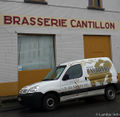Brasserie Cantillon
Website (French, Dutch, English): http://www.cantillon.be
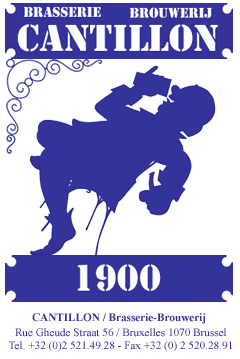
Facebook:https://m.facebook.com/profile.php?id=100057306646657
Instagram: @brasseriecantillonofficiel
Email:[email protected]
Phone: +32 2 521 49 28
Address: 56 Rue Gheude, B-1070 Brussels
Open Mon, Tues, Thu, Fri, Sat 10am - 5pm (last call is 4pm, store open until 5pm)
Closed Wed & Sun
Overview
Cantillon is the only traditional lambic brewery located within the city of Brussels. Founded in 1900, today Cantillon operates both as a brewery and as a living museum, the Brussels Gueuze Museum (Musée bruxellois de la gueuze). Cantillon uses 100% organic grains and hops in all of its beers. Cantillon brews traditional lambic products, using 65% malted barley and 35% unmalted wheat. The beers are spontaneously fermented using a large coolship in the attic of the brewery and then fermented in oak barrels.

In addition to their flagship beers, Cantillon brews a variety of beers for special occasions and experimental releases. The brewery hosts Zwanze Day, Quintessence, and Cantillon Public Brewing Sessions. Cantillon also participates in the Weekend of Spontaneous Fermentation, the Night of the Great Thirst, and a variety of other festivals worldwide.
History
The roots of Brasserie Cantillon stretch back even further than the brewery’s officially recognized founding date of 1900. According to Van den Steen in Geuze & Kriek: The Secret of Lambic Beer, the forefather of the Cantillon brewing family was a grain merchant named Auguste whose son, Paul, had no intention of continuing his father’s craft. Auguste then began to search for a business that would suit his son’s brewing hobby. Since starting a brewery was too expensive, Auguste made several attempts to take over breweries in the Lembeek area. By 1894, Auguste had bought the Vandezande-Van Roy brewery located in Lembeek’s Hondzocht district, which was active until 1925 as Cantillon Fréres.[1]
By 1900, Paul Cantillon and his wife Marie Troch began a gueuze blending business in the industrial quarter of Cureghem which was part of the southern Brussels community of Anderlecht. The brewery was located in a very busy area near the Bruxelles-Midi train station, the Mons boulevard, and the canal that ran through the city. Jean-Pierre Van Roy, who wrote the forward to La Gueuze Gourmande, calls the period between 1900-1937 the "première periode de la brasserie." During these first thirty-seven years, Cantillon never actually brewed a beer. Instead, they bought lambic from a variety of producers in the area to blend and sell on their own, considering Cantillon a biersteker (beer blender) and marchand de bières (beer merchant). They would house their beers at Gheudestraat 56-58, where the brewery is located today.[2]
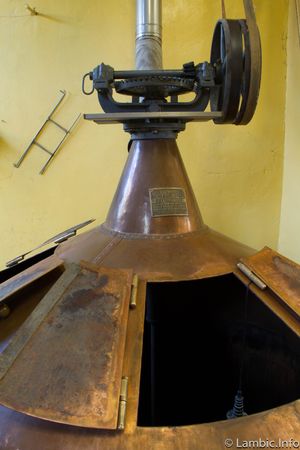
Paul and Marie had four children, two sons named Robert and Marcel, and two daughters named Georgette and Fernande. The early years of Cantillon produced unblended lambic, mars, faro, gueuze, kriek, and framboise. After the First World War, Paul was ready to expand the business and bring his two sons into the fold. In 1937, Paul, Robert, and Marcel purchased the Brasserie Nationale du Néblon, located in Ouffet, which had closed the previous year. They moved the brewing equipment to its current location, and the first batch of Cantillon’s own beer was brewed in 1938, shortly before the brothers were called to mobilize for World War II.[1]
During the Second World War, with supplies in demand for the soldiers, it was more difficult to continue to brew beers. The period during the war saw the brewery at a near standstill. The immediate post-war years did not see the same demand and production of beers as the 1930s had. To make matters worse, a massive heat wave in Belgium destroyed many breweries’ stocks including Cantillon’s. Sometime around 1950, the brewery began to recover and reached an all-time high production in 1955. Paul Cantillon passed away in 1952, while his wife Marie lived until 1958. Starting in 1960, the demand for traditional gueuze and lambic began to decline once again, and Robert sold his share to Marcel and left the business. Marcel, too, was on his way out of the brewing business when his only daughter, Claude, married Jean-Pierre Van Roy. In August 1969, Van Roy had agreed to take the reins of the brewery. From October 1969 until April 1970, Jean-Pierre apprenticed with his father-in-law Marcel Cantillon, learning the trade. [3]
To keep the brewery afloat, Van Roy sweetened his gueuze with artificial sweeteners to keep up with current tastes. Sadly, this did not help the brewery and it continued to operate at a loss. By 1975, Jean-Pierre began to abandon the artificial sweeteners and stopped the practice altogether by 1978. In 1978, he also decided to create a working exhibit dedicated to the art of lambic brewing. Opening Cantillon to the public allowed the brewery to bring some extra revenue to help balance the books. It also helped to spread the word to both locals and to tourists.[1]
Sales began to increase. In 1986, Cantillon began exporting to the United States.[4] Jean-Pierre continued to take steps to increase quality control, including discontinuing sales to stores that stored the beer upright. Storing the bottles upright caused the cork to dry out and let all the carbonation out. Jean-Pierre eventually brought his son, Jean, into the business in 1989. Like his father, who had no formal brewing experience before working at the brewery, Jean Van Roy learned lambic on the job.
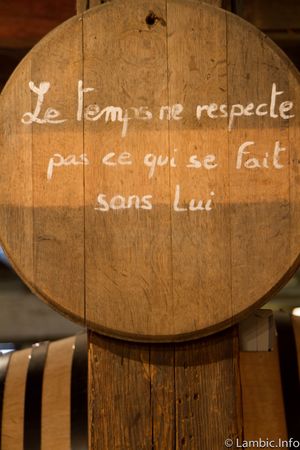
In the years since 1992, the brewery has continued to flourish as one of the most sought-after producers of traditional lambic in Belgium. Though still involved in the brewery, the elder Van Roy brewed his last official batch in 2009. Jean Van Roy, who spent a full twenty years working beside his father, now directs the brewery’s operations after having officially taken over in 2003. Unlike his father before him, who was rooted in the strictest tradition, Jean Van Roy has grown to experiment with a number of small batch lambics and fruits not native to Belgium, like Finnish red currants and Danish bilberries. As of now, the future of the brewery seems to be quite stable with no less than seven grandsons of Jean-Pierre and Claude ready to carry on the Cantillon name.[5][1]
In August 2014, Cantillon announced via Facebook that they would be expanding with enough space to double their production. They purchased an adjacent building that once housed a lambic blender, Brasserie Limbourg. The increase in production will be realized during the 2016-17 brewing season.
Underground Cellar
In 2011, Jean started a long-term lambic aging process in cooperation with the city of Brussels. The city is providing the underground cellaring space free of charge where Cantillon plans to eventually age 60,000-80,000 bottles in long-term storage over twenty years. He plans to focus primarily on aging Gueuze, Bruocsella Grand Cru, and Lou Pepe Kriek, but will also incorporate smaller aging initiatives with other Cantillon beers [6]
This cellaring project is the largest of its kind for aging lambic. Chuck Cook at drinkbelgianbeer.com visited in 2014 and wrote of his experience.[7].
Production Notes
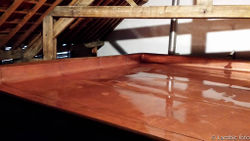
Cantillon follows traditional lambic brewing processes, with the following notable facts:
- Until 1990, Cantillon used a foeder for blending. Since then however, fruit additions and lambic blending is done in stainless tanks to allow for larger, more consistent blends and ease of blending and cleaning.[8]
- The fruit is flash frozen, allowing the beers to be brewed throughout the season using consistent fruit. Previously, because fresh fruit drove the brewing process, Cantillon would potentially have to use older or younger lambic to time the process around the fruit harvest.
- Cantillon uses pipes (primarily wine barrels from France, Italy, and Spain) rather than foeders for aging lambic.[1]
- Small blends and test batches are done in 20 L vessels rather than the stainless tanks. Due to the size of these experiments, many of the beers discussed below are not intended for public consumption
- Late in the season, the 1-year-old lambic is closer to 18-20 months old and no longer has enough residual sugar for natural secondary fermentation in the bottle. In those cases, Cantillon will add 2-3 g/L of liquid saccharose. [9]
- Cantillon historically sourced hops from large local hop farms in cities such as Asse and Affligem, Belgium. Over time, these farms have shrunk. In the 1970s, Cantillon was sourcing hops from the Yakima Valley in Washington. Currently, most hops come from Germany, however in 2012 and 2013, the hops did not age well and Cantillon is looking to move back to US hops.[10]
- In the 1980s and 1990s, Cantillon often used colored foils to designate the style of beer. Gold or yellow foil indicated gueuze, red foil was used for kriek, purple or silver foil was used for framboise.
Beers
Gueuze
- Amitié & Joie 40ème Anniversaire Super Gueuze
- Brabantiae
- Chouke
- Classic Gueuze 100% Lambic
- Crémant de Gueuze
- Crianza Helena
- Cuvée de Florian
- Cuvée de l'Espérance
- Cuvée du 120eme
- Cuvée du 25eme
- Cuvée I.P.A. 25 Jaar
- Cuvée J. F. Vonck
- Cuvée du Millénaire
- Cuvée U.G.M. Belair Gueuze 1997
- Florian Van Roy
- Gouden Voeten Gueuze
- Gueuze 125
- Gueuze 2-3-4
- Gueuze Lombard BXL-BD Grand Cru
- Gueuze Tourbée
- Gueuze Vélomoteur
- Heerengeuze
- Hopduvel 10 jaar Gueuze
- Jean Chris Nomad 2011
- La Gueuze du Poje
- La Gueuze et l’Ecaille
- La p’tite Louise
- Loerik (Lazy Gueuze)
- Moeder Lambic Fontainas Cuvée X Browsel
- Monk's Café Cuvée De Monk's Gueuze
- Super Gueuze
- Sylvain Van Roy
- V Generations
Faro
Fruit
- 20 Ans d'Amitié
- Amitié et Joie 40ème Anniversaire Kriek
- Amitié et Joie 40ème Anniversaire Framboise
- Aigre de Kriek
- Aronia
- Belle Mirabelle
- Blåbær Lambik
- Brussels Sprouts Lambic
- Camerise Lambic
- Citoyen du Monde
- Cuvée du Cercle Industriel
- Cuvée Florian
- Cuvée Moeder
- Cantillon Cuvée U.G.M. Belair Kriek 1997
- Du Lambic dans les Prés
- Feestbier
- Fou' Foune
- Framboise
- Frambozenlambiek
- Gouden Voeten Kriek Lambic
- Groseille Lambic
- Groseille à Maquereau
- Guy De Wits Fruitkorflambiek
- Hopduvel 10 jaar Framboos
- Hopduvel 10 jaar Kriek
- Kersengueuze
- Kriek 100% Lambic
- Lambidre Fermier de Bruxelles
- Lou Pepe - Framboise
- Lou Pepe - Kriek
- Magic Lambic
- Monk's Café Cuvée Kriek
- Mozart
- Nath
- Nèfle
- Noyau
- Pure Apricot
- Rosé de Gambrinus
- Sang Bleu
- Soleil De Minuit
- Spuyten Duyvil
- Tyrnilambic Baie D’Argousier Lambic
Grape Lambic
Cantillon has, over time, done more lambic and grape experiments than any single fruit. This list has been broken out of the fruited lambic category and given its own section to reflect this. This category does not include blends of lambic aged in specific wine barrels which do not contain fruit.
- Aglianico
- Barbera
- Beck-Hartweg
- Benedikta 25
- Cantina Giardino
- Carignan
- Chardonnay
- Chenin Blanc
- Cinsault
- CLAC (Trois Cépages)
- Cantillon Cuvée Moeder 10 Ans - Cab Franc
- Divin Lambic
- Don Quijote
- Drogone Lambic
- Druivenlambik (Cuvée Neuf Nations)
- E Basta
- Goldackerl Gueuze
- Goldackerl Lambic
- Grenache Blanc
- Grenache Noir
- Gueuzestraminer
- La Corvée
- Lambic d'Aunis
- Lambic Sangiovese
- L’Éclat
- Le Plaisir
- Menu Pineau
- Mourvèdre-Carignan
- Muscat Petits Grains
- Nuit Bruxelloise
- Pinot (Pineau) d'Aunis
- Piacere
- Pinot Meunier
- Poulsard
- Racine
- Racine sur Lie
- Riesling Blend
- Reed Gueuze Muscat
- Reed Gueuze Pinot Noir
- Saint Lamvinus
- Saint Lamvinus Grand Cru
- Saint Lamvinus Unblended
- Scarabée
- Scarabée-Timorasso
- Signorina
- Sophia Lambic
- Tarlantillon
- Trousseau
- Timorasso
- Vigneronne
- Vin Santo
Herbed / Spiced
Jeune Lambic
Vieux Lambic
- 50 Degrees North - 4 Degrees East
- Alliance
- Amarillo Lambic
- Amphora Lambic
- Assemblage de l'Amitié (Wild Friendship Blend)
- Bière du Dragon
- BLIPA
- Bourgogne Lambic
- Cognac Lambic
- Couvreur
- Cuvée 1904
- Cuvée Bonheur des Petits Loups
- Cuvée Des Champions
- Cuvée du Petit Oiseau
- Cuvée Kuaska
- Cuvée Roxane et Charlotte
- Cuvée Saint Gilloise
- Geif Coroge
- Grand Cru Bruocsella
- Grand Cru Bruocsella Brut
- Het Bier Gevaar
- Hoeve Lambic Fermier
- Iris
- Iris Grand Cru
- Klara Festival
- La Dernière Cuvée Du 89
- Lambic Fumé
- Lambic d'Haute Densité
- Lambic Vin Jaune
- La Vie est Belge
- La Vie est Solidaire
- LH12
- Lou Pepe Gueuze
- Moeder Lambic Fontainas Cuvée X Browsel
- Manzanilla
- Pikkulinnun Viskilambic
- Symbiose
- Cantillon Super Blend - Akkurat 20th Anniversary
- T42
- Vieux Lambic
- Vin de Paille
- Y12 Trinidad
- Y12 Jamaica
- Y30
Cantillon Zwanze Day
Main article: Cantillon Zwanze Day
Since 2008, Cantillon has released a special beer known as Zwanze. The beer itself is usually an experimental beer that may or may not be brewed again. Since 2011, there has been a coordinated celebration around the world to introduce this beer.
Beginning in 2024, Zwanze will be celebrated every other year, alternating with Quintessence.
Zwanze Series
- Zwanze 2008 (Rhubarb Lambic)
- Zwanze 2009 (Elderflower Lambic)
- Zwanze 2010 (Spontaneous Witbier)
- Zwanze 2011 (Pineau d’Aunis Grape Lambic)
- Zwanze 2012 (Rhubarb Lambic)
- Zwanze 2013 (Spontaneous Abbey)
- Zwanze 2014 (Cuvée Florian - Dry Hopped Iris Grand Cru with Cherries)
- Zwanze 2015 (Wild Brussels Stout - Spontaneous Fermentation Stout)
- Zwanze 2016 (Framboise lambic with blueberry and vanilla)
- Zwanze 2017 (Oolong Tea Lambic)
- Zwanze 2018 (Italian wine barrel lambic)
- Zwanze 2019 (Smoked lambic)
- Zwanze 2020 ("Brettrave" - Beetroot lambic)
- Zwanze 2021 ("Parasol" - Orange lambic)
- Zwanze 2022 ("Poivre des Gorilles" - black pepper lambic)
- Zwanze 2023 ("Ghost lambic")
- Zwanze 2024 (“Gueuze Under The Sea” - sea lettuce lambic)
- Zwanze 2026 ("Red & White Vermouth lambics" - vermouth & lambic hybrids)
Zwanzer's Club
In early 2021, Cantillon started a club called the Zwanzer's Club. Members were selected among friends of the brewery (many of them being long time members of the Brussels Gueuze Museum) in gratitude for their support over the years. Members were allowed to purchase an allotment of special bottles (more limited and usually dedicated to be opened on-site at the brewery's taproom) for takeaway, about once a year or so. With acceptance of this membership, one agreed that they would only purchase what they would drink themselves. No further memberships are accepted at this point in time. This is to avoid people reselling these special bottles on the secondary market at a premium, and also due to the limited amount of bottles available.
Breweriana
Photos
Podcast
Basic Brewing Radio May 30, 2013 Podcast with Jean Van Roy
<mp3player>http://traffic.libsyn.com/basicbrewing/bbr05-30-13cantillon.mp3</mp3player>
The Sour Hour May 7, 2015 Podcast with Rob and Jason from Allagash, Jean from Cantillon, and Vinnie from Russian River
<mp3player>http://www.thebrewingnetwork.com/membersarchive/sourhour2015_05_wildfriendship.mp3</mp3player>
Belgian Smaak August 31, 2017 Podcast with Jean Van Roy
<mp3player>http://media.blubrry.com/belgiansmaak/p/traffic.libsyn.com/belgiansmaak/EP009.mp3</mp3player>
Radio Vino April 2022 Podcast with Jean Van Roy (French)
Videos
- http://www.een.be/programmas/dagelijkse-kost/artisanale-lambiek (a video interview with Jean in Dutch with clips of the 2014-2015 brewing season)
References
- ↑ 1.0 1.1 1.2 1.3 1.4 Jef Van den Steen, Geuze & Kriek: The Secret of Lambic Beer, 2012
- ↑ Nicole Darchambeau, La Gueuze gourmande, 2006
- ↑ Jean-Pierre Van Roy interview, Trends Family Business, November 2017. "Hoeders Van De Traditie."
- ↑ Lambic.Info Interview with Jean Van Roy and Jean Pierre Van Roy, May 2015
- ↑ Tim Webb, Chris Pollard, Siobhan McGinn, LambicLand: A Journey Round the Most Unusual Beers in the World, 2010
- ↑ Lambic.Info Interview with Jean Van Roy and Jean Pierre Van Roy, May 2015
- ↑ Chuck Cook, Cantillon’s Bomb Shelter Cellar, 2014
- ↑ Lambic.Info Interview with Jean Van Roy and Jean-Pierre Van Roy, May 2015
- ↑ Basic Brewing Radio Podcast, May 30, 2013
- ↑ Lambic.Info Interview with Jean Van Roy and Jean Pierre Van Roy, May 2015

